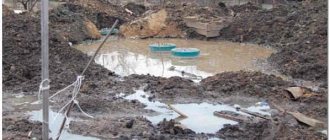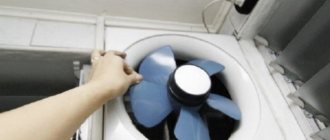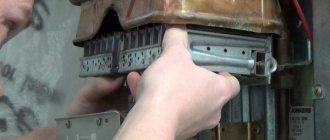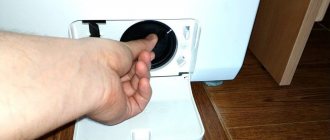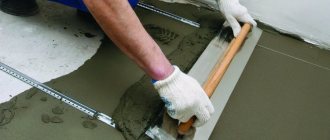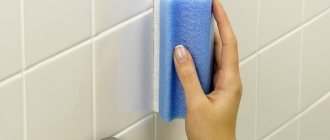High indoor air humidity is the main cause of mold development.
Molds spoil things and the environment, and also pose a danger to humans, as they increase the risk of allergies and respiratory pathologies.
A set of measures will help remove dampness, and preventive measures will help maintain the humidity level at normal levels.
For more information on how to remove humidity in an apartment, room or house, read the article.
Causes of the problem
Constantly high humidity in the room must have a specific reason. In some cases, the source of moisture can be determined quickly.
This may be an external defect during the construction of the facility or one that arose during operation as a result of wear and tear of structural elements:
- leaking roof;
- violation of the integrity of the outer wall, the tightness of the slabs;
- flooding;
- ventilation system defect.
Internal reasons for the appearance of high humidity include violation of operating rules:
- the location of several aquariums or other open containers with water in a room that is not designed for this;
- growing tropical or other plants that require abundant watering in large quantities;
- frequent drying of large amounts of laundry;
- cooking food in open pans;
- lack of sealing of windows;
- leaks in pipes (sewage, water supply, heating).
If a source of high humidity is identified, it should be eliminated.
No. 3. Water containers throughout the apartment
Another simple option for natural hydration. If now you have imagined buckets and basins of water throughout the apartment, and have already become desperate, then we hasten to tell you a nicer and no less effective option for organizing humidification of this kind.
A beautiful vase in a minimalist style can serve as a container . These are often used as interior decoration, so if you add another function, no one will notice. The main thing is that no one knocks over the vase. Water can be poured into a transparent container; an aquarium will do. It is not necessary to have fish (but if you want and are not afraid of care, why not), and you can decorate the container with beautiful stones, decorative algae, shells or houses - all this stuff is sold in the same place where aquariums with fish are sold. Just remember to change the water and wash the containers occasionally.
An aquarium or indoor fountain will also increase humidity.
Determining the level of dampness in a room without instruments
A normal humidity level is considered to be between 40 and 60%. A hygrometer can be used to determine the exact level of air humidity. But even without it it is possible to draw conclusions about the humidity in the room. The easiest way is to use a glass of water.
Procedure for conducting the experiment:
- Pour water into a regular glass glass with transparent walls.
- Place the glass in the refrigerator, bringing the temperature of the liquid to +5°C. Water at room temperature can reach this value in a few hours.
- Take the glass out of the refrigerator and place it in the room. At the same time, it is necessary to control that it is not directly affected by heat from radiators, stoves with food being prepared and other appliances.
- If, after fogging, the walls of the glass dry out in just a quarter of an hour, this indicates low humidity. If after fogging the walls do not dry out, but drops begin to form and flow down, the humidity is high. In the case when the condensate that appears does not quickly evaporate, but does not drain, the humidity in the room is normal.
Another way to determine humidity is to bring a spruce or pine cone into the house and observe how the scales behave. When placed in a room with dry air, they will begin to dry out and open. If the air is damp, they will close together.
High humidity can be indicated by:
- fogging of windows in the house;
- clothes that take a long time to dry after washing;
- slow drying of floors after washing.
Such tests have low accuracy and do not provide specific numbers.
No. 2. Towels and bottles on the radiator
A simple folk method is to hang a damp towel on the radiator . The advice is effective, but you will have to change or re-wet the towel very often, because resourceful housewives once came up with the idea of dipping the tip of a towel/gauze/cotton fabric into a plastic bottle suspended from the radiator, in which they made a hole in the wall and poured water into it.
Another option is to simply hang a few water bottles behind the radiator . To ensure that the evaporation area is sufficient, it is better to make a hole in the wall rather than just unscrew the lid. The bottle can be decorated.
A more modern way is special humidifiers for the battery . The principle of operation is the same as that of simple bottles, but it will all look prettier. Such humidifiers are also filled with water, which then evaporates naturally; only the devices themselves are made of ceramics, steel, plastic and other materials. They can have almost any shape and color, so they will fit well into the interior, becoming its unusual decoration. Guests who are not in the know may not understand at all that this is a humidifier and not decor.
Tip – you will most likely need several bottles or humidifiers to speed up the hydration process.
Remedies
There are several ways to quickly remove high humidity. You need to take into account the specifics of the room, its area and the ability to implement one or another method of air drying.
Ventilation
Ventilation does not remove the smell of dampness and neutralize high humidity in all cases. This method will help if the weather outside is dry.
It will also be useful:
- Ventilate the bathroom after bathing and heavy laundry.
- Organize good air exchange in the room in which food is prepared.
- Ventilate the room after wet cleaning and other work using large amounts of water.
Heating
Warming up the room during the cold season, when the air temperature inside the building increases significantly, also helps to reduce humidity levels. The result can be achieved by installing additional heating devices - heaters.
When using heaters, there is a danger of drying out the room , and then you will have to deal with another problem - increased dryness. Therefore, it is important to maintain a middle ground.
Special tablets
One solution to the problem of increased dampness is to purchase special tablets that contain absorbent components. They are used with desiccants - containers for collecting the solution that is formed from absorbed moisture.
The productivity of the tablets is up to 400 ml of water per month in a room of up to 20 m². On average, such a tablet should be enough for 2 or 3 months of use.
Products from such well-known manufacturers have good reviews:
- "Stop humidity" from Henkel;
- “Stop moisture” from Ceresit and others.
Folk remedies
Absorbents, which can be used as improvised means, will help dry humid air:
- sugar;
- coffee beans;
- salt;
- rice.
These products have the ability to absorb increased moisture. To normalize humidity, these products can be placed in containers - several per room.
In addition to removing moisture from the air, the products listed can remove unpleasant odors .
For non-residential utility premises, the following containers placed in containers will help remove excess moisture from the air: quicklime, coal, calcium chloride. This method is suitable for damp basements, garages, workshops, etc.
Dehumidifiers
Special devices are used to force dry the air in the room. They allow you to achieve results even in cases where other methods of combating moisture have not helped.
Operating principle of the devices:
- Air absorption through the evaporator.
- Liquid conditioning occurs in the device due to temperature differences. The water flows into a separate container.
- The flow of dried air is returned back into the room.
The advantages of dehumidifiers are the ability to dry even very humid air in a short time.
There are two types of devices:
- Stationary.
- Portable.
The choice depends on the intended use of the device and whether it will need to be moved. It should be borne in mind that stationary models are more powerful, larger, and are not intended to be moved from place to place. For apartments, preference is most often given to dehumidifiers that can be moved from place to place.
The power of the dehumidifier is a very important parameter that must be taken into account when purchasing a device.
NeoClima ND-10AH
Floor installation is designed for rooms with an area of 16 m² . The weight of the device is 11.5 kg. The productivity of the device is 10 liters per day. The model has a filtration system to remove dust particles and wheels to move the device.
The NeoClima dehumidifier is equipped with a timer and display, which makes operation easier. Operating modes – 2, power – 0.23 kW. The volume of the container for collecting condensate is 1.5 l.
Additional functions:
- when the container is filled with condensate - automatic shutdown;
- automatic defrosting.
Price – up to 12,000 rubles. Read reviews here, here and here.
Electrolux EDH-12L
The device is designed for floor or tabletop use in a small room with an area of 15 m², and has a carrying handle. The power declared by the manufacturer is 0.245 kW . The weight of the device itself is 10 kg.
Electrolux has 4 operating modes, productivity – 12 liters per day. The volume of the condensate container is 2.2 liters. The device is completely ready for use and does not require additional installation. The model has indicators and a display.
Additional functions:
- ability to set shutdown time;
- the presence of a clothes drying mode.
The cost is on average about 13,000 rubles, at some points of sale – up to 17,000 rubles. Read reviews here.
Ballu BDM-30L
The Ballu dehumidifier is a floor-standing unit that has electronic controls for quickly setting settings, a built-in timer, indicators and display. The device allows you to dehumidify the air in a room of 50 m². Capacity – 30 liters per day .
The volume of the condensate container is 5 liters. Maximum power – 0.54 kW. The weight of the entire device is 14.6 kg.
Additional functions:
- Air ionization.
- Automatic shutdown when the container is full of condensate.
- Possibility to adjust fan speed.
- Set off and on times.
- Clothes drying mode.
Cost – about 22,500 rubles. Read reviews here and here.
Installation process
Installation
In order to install the fan as quickly as possible, you should prepare the place in advance during repairs, namely, install the power supply and make an exhaust hole of the required size. If all this was done in advance, then the installation process will take even the most inexperienced person no more than half an hour.
Installation proceeds as follows:
- First, the fan is prepared: remove the grille;
- Apply construction adhesive to the side that will later be joined to the wall;
- We attach the fan to the prepared exhaust hole, hold it pressed for 5 minutes so that the glue sets;
- We connect it to the power supply, this stage may be the third, depending on the design of the equipment;
- We fix the fan grille in place.
Features of eliminating high humidity in summer, winter, and off-season
In the warm season, simple ventilation with good air exchange will help reduce the humidity in the room. To do this, just open the windows.
But in the off-season and winter, this option is not suitable due to inefficiency. When there is high humidity outside, it is better to use other methods to eliminate moisture in the house:
- heating;
- dampness tablets;
- dehumidifiers.
Regardless of the time of year, it is necessary to remember about preventive measures to prevent high humidity.
Aquarium
What child doesn't dream of fish in an aquarium? The colorful inhabitants of a small pond will lift your spirits, and the aquarium itself will create a unique coziness. You can additionally install a pump with an artificial fountain in the aquarium, which will add the amount of evaporated air into the home.
Since a person is 85% water, humidifying the air in an apartment is a pressing issue that increasingly arises in everyday life. And in order for this parameter to be normal, you need to use any methods and means. Moreover, their quantity and variety allows you to choose the optimal one and feel great in a clean, fresh room with air of sufficient humidity.
Prevention measures
Preventative measures to prevent high humidity in the house include the following:
- Carrying out waterproofing work to prevent moisture from entering rooms - eliminating leaks, ensuring the tightness of windows, sealing floors, insulating walls, etc.
- Cooking food must be covered. This will prevent the formation of steam and, as a result, an increase in humidity.
- The premises should not be used for other purposes.
- It is necessary to regulate the permissible number of water containers in one room.
- Installing a hood in the kitchen will reduce moisture levels in the air.
- Checking the functionality of the ventilation system and repairing it, if necessary.
- If the room is damp, it is not advisable to place aquariums in it.
- Choosing reliable plastic windows is one way to prevent excess humidity.
- It is best to move drying clothes outside or to the balcony, avoiding hanging wet things indoors.
Why is dry air harmful and why do you need to humidify it?
- The mucous membranes become dry. There is an unpleasant feeling in the throat, a sore throat, crusts form in the nasal sinuses in children, and difficulties in wearing lenses occur in adults - constant dryness is felt.
- The risk of exacerbation of asthma and allergies increases. If there is a lack of moisture, more dust forms in the room, making it more difficult to breathe. Signs of allergic reactions can appear even in healthy people.
- The number of viruses and bacteria increases. The necessary conditions are created to increase the rate of their reproduction, which can cause various diseases, from ARVI to coronavirus infection.
- Feeling worse.
You may experience increased fatigue, a persistent desire to sleep during the day, decreased attention, and possible headaches and other symptoms. A research project within the American Wellbuilt for Wellbeing program showed that specialists working in offices with humidity below 30% are 25% worse able to cope with stressful situations and external stimuli. - Skin problems appear. A low moisture content causes dry and flaky skin, brittle nails, and deterioration of hair condition.
- Static electricity occurs. It is especially noticeable in winter, when due to excessive dryness things begin to “shock” and hair becomes electrified.
Owners of indoor plants, solid doors, libraries, collectible art objects, rooms with parquet, furniture and wood panels, etc. should think about how to increase the humidity in the apartment. The consequences of a lack of moisture can be described for a long time, but it is worth understanding that high humidity is undesirable, so everything should be in moderation.
According to the recommendations of the World Health Organization (WHO), a comfortable moisture level for people is 40–60%. According to GOST 30494-2011, in residential premises the humidity should not be lower than 30%, the maximum depends on the season - up to 60% in winter, up to 65% in summer. For office employees and workers carrying heavy objects, in 2021 they decided to expand the range of optimal humidity; indicators from 15 to 75% are considered normal (according to SanPiN 1.2.3685-21).
Recommendations
combat high indoor humidity :
Without eliminating the root cause of high humidity in the house, any measures taken will only have a temporary effect and will not radically solve the problem.- If the moisture problem has been ongoing, the area should be inspected for mold growth. If fungus is detected, the apartment (house) should be treated with special means.
- If, after eliminating high humidity in the room, the smell of dampness continues to persist, you can use purchased or natural flavors - coffee beans, vinegar, essential oils, etc.
Instructions for creating an assimilation dehumidifier with your own hands
The operating principle of an assimilation dehumidifier is based on constant air exchange: wet air is physically displaced outside the room and is replaced by drier air from outside. Such devices are good for industrial facilities where significant volumes of gas have to be distilled. Weak sides:
- low energy efficiency (high electricity costs, high heat losses);
- impossibility of use in humid climates (coastal areas).
Industrial assimilation devices are expensive. The starting price of the equipment is 400 thousand rubles. Experts do not recommend making equipment yourself, as it is expensive and is not intended for home use.
Instructions for creating a do-it-yourself condensation dehumidifier
The most popular type of dehumidifier for apartments is based on condensation - the release of water from the air when the temperature drops. An example of condensation is dew, and it is this process that is reproduced technologically.
The moisture collector cools the air according to the principle of an air conditioner, but without removing heat outside the room.
Equipment
Components of the device and principle of operation:
- evaporator - a cold heat exchanger (in which the air is brought to a temperature below the dew point);
- condenser - a hot heat exchanger (in which the dried air is heated again and released outside);
- storage tank (condensate drains into it).
A home appliance can easily be constructed from an old refrigerator with a working compressor. For assembly you will need:
- unused refrigerator;
- plexiglass with a thickness of more than 3 mm;
- household fan with a power of 100 W or more;
- plastic grate (pressure);
- fastening elements (screws);
- sealant (electrical tape, silicone);
- tools (screwdrivers, screwdriver, hacksaw).
The device must be assembled from these components according to the instructions.
Instructions for creating a do-it-yourself adsorption dryer
A dehumidifier based on adsorption principles is more widely used for home use. The heart of the structure is a material capable of absorbing water from the air. The active substance may be:
- silica gel;
- Activated carbon;
- rice.
A homemade device is easy to make according to the instructions. In this case, it is important to ensure not only the absorption of moisture by the adsorbent, but also the periodic “recharge” of the active substance. The material must be dried and, after a certain number of cycles, completely replaced with a new one.
Equipment
Standard composition of adsorption dryer:
- frame;
- rotor block;
- adsorbent;
- heat exchange compartment;
- heater;
- fan.
Based on this, it is not difficult to select elements for a homemade design. To create a dehumidifier for your home you will need:
- two plastic bottles of the same volume;
- awl;
- lighter (matches);
- silica gel or other adsorbent;
- cutting tools;
- fan (cooler) with batteries or with a USB cable for connection to the mains;
- tape, glue gun.
The volume of bottles is selected based on the dimensions of the room. For effective operation, it is recommended to use containers of at least two liters.
Assembly
To create a moisture absorber for your home, you need to complete the assembly step by step:
- One of the plastic containers needs to be cut in half.
- Using an awl or needle heated over a fire, you need to make several holes in the bottom and plug.
- You need to turn the top of the bottle with the cork down and insert it into the bottom.
- You need to pour the adsorbent into the resulting funnel.
- The second bottle needs to be freed from the lid and the bottom cut off.
- Having retreated 10-12 centimeters from the bottom of the container, you need to secure the fan (you can use a glue gun or double-sided tape) so that when working it blows downward (toward the cut).
- Finally, you need to connect the two bottles (put the pipe with the cooler on the funnel) and seal the joint with tape.
- To start using the fan, you need to provide electrical energy from the mains or batteries (accumulators).
The resulting device is distinguished by its simplicity and almost silent operation.
We recommend:
How to remove a handle from a leather sofa at home
Important! A desiccant dehumidifier can operate even at low temperatures, which is why the devices are used in refrigeration units and ice arenas.
